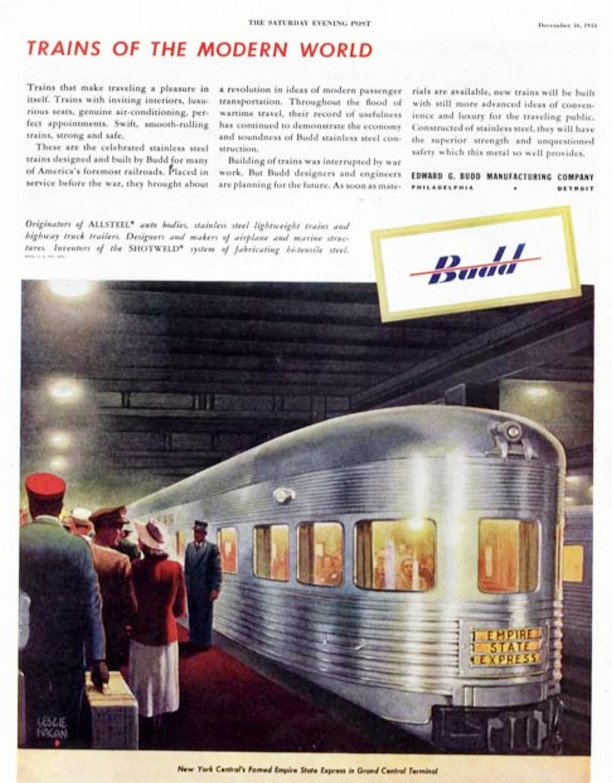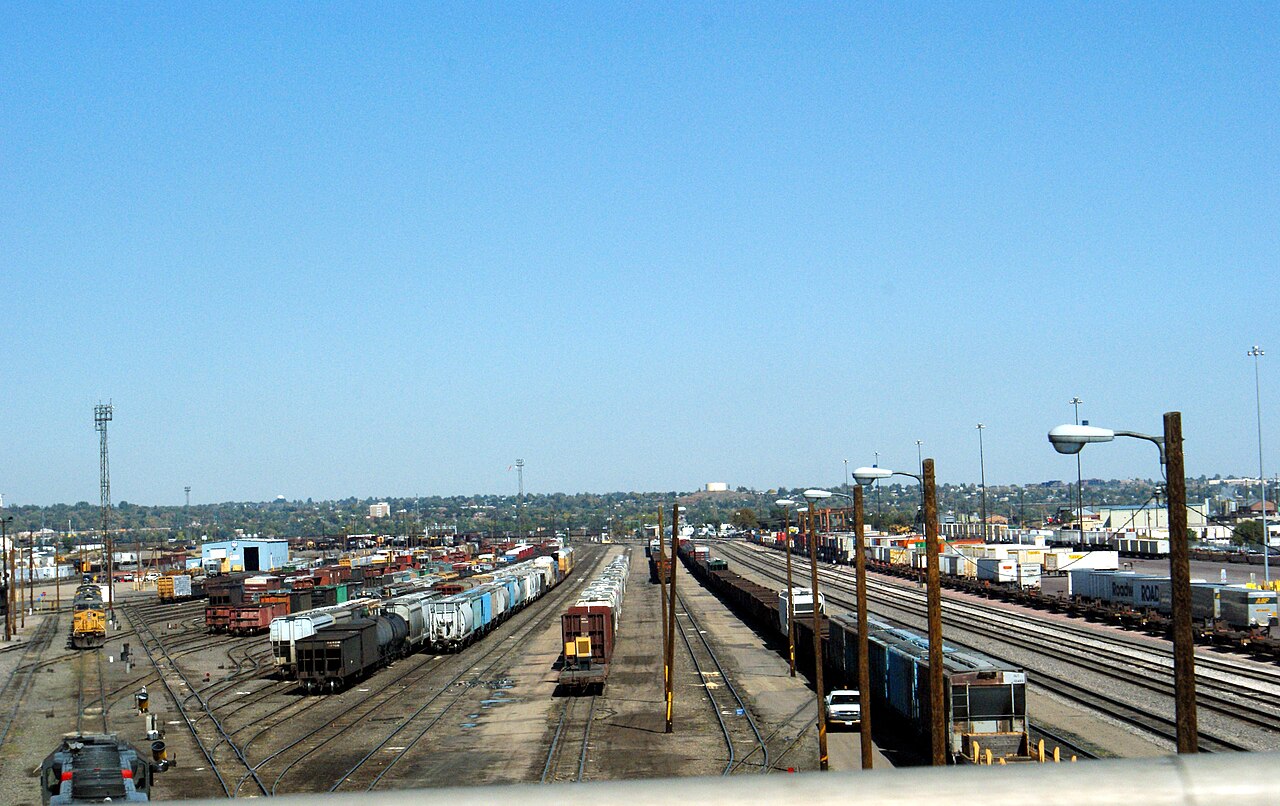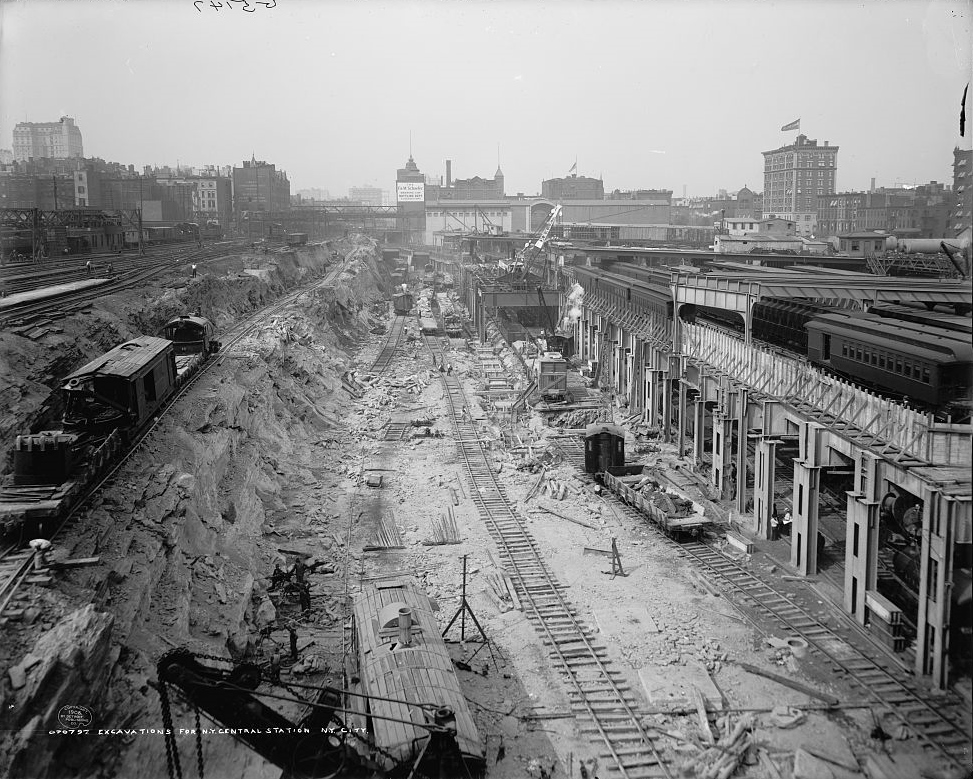NYC Hudson Locomotive, built with iconic Streamlining
designed by Henry Dreyfuss, used to haul
The 20th Century Limited Train, starting in 1938.
Photo courtesy SMU.
Date: 1938.
Source: Southern Methodist University, Central University Libraries, DeGolyer Library: Robert Yarnall Richie Photographs. Retrieved from Flickr: Hudson Locomotive for The New York Central.
Author: Robert Yarnall Richie (1908-1984).
(Wikimedia Commons)

English: Grand Central Station Terminal,
42nd Street, New York,
United States of America.
Français: Vue extérieure nocturne de la gare
Grand Central Terminal sur l'ile de Manhattan, à New-York (États-Unis).
Date: 1/08.
Source: Own work.
Author: Fcb981 ; Eric Baetscher (attribution required).
(Wikimedia Commons)
On 1 February 1968, The New York Central was absorbed by The Pennsylvania Railroad, forming the new Pennsylvania New York Central Transportation Company, that was eventually re-named The Penn Central Transportation Company, with The NYC's Alfred Perlman as President. Penn Central was quickly saddled with debt, when The ICC forced the money-losing New York, New Haven and Hartford Railroad into the new Railroad in 1969. In addition, the merger was handled in a haphazard manner, with no formal merger plan implemented. The two Companies' competing Corporate Cultures, Union Interest, and incompatible Operating and Computer Systems sabotaged any hope for a success.
Additionally, in an effort to look profitable, The Board of Directors authorized the use of the Railroad's Reserve Cash to pay Dividends to Company Stockholders. Nevertheless, on 21 June 1970, Penn Central declared Bankruptcy, the largest Private Bankruptcy in The United States to that time. Under Bankruptcy protection, many of Penn Central's outstanding debts, owed to other Railroads, were frozen, while debts owed to Penn Central, by the other Railroads were not. This sent a trickle effect throughout the already fragile Railroad Industry, forcing many of the other North-Eastern Railroads into Insolvency, among them The Erie Lackawanna, Boston and Maine, The Central Railroad of New Jersey, The Reading Company, and The Lehigh Valley.

Penn Central marked the last hope of privately-funded Passenger Rail Service in The United States. In response to the Bankruptcy President Richard Nixon signed into Law, The Rail Passenger Service Act of 1970, which formed The National Railroad Passenger Corporation, better known as Amtrak, a Nationalised, Government-owned and subsidised Railroad. On 1 May 1971, Amtrak assumed the responsibility of most Regional and Long-Distance Inter-City Passenger Trains in The United States. Amtrak would eventually assume ownership of The Northeast Corridor, a mostly-electrified route between Boston and Washington, D.C., inherited primarily from The PRR and New Haven Systems. Penn Central and the other Railroads were still obligated to operate their Commuter Services for the next five years while in Bankruptcy, eventually turning them over to the newly-formed Conrail in 1976. There was some hope that Penn Central, and the other North-Eastern Railroads, could be restructured towards profitability, once their burdensome Passenger deficits were unloaded. However, this was not to be and the Railroads never recovered from their respective Bankruptcies.

Conrail, officially The Consolidated Rail Corporation, was created by The U.S. Government to salvage Penn Central, and the other Bankrupt Railroads' Freight business, beginning its operations on 1 April 1976. As mentioned, Conrail assumed control of Penn Central's Commuter Lines throughout the Lower Hudson Valley of New York, Connecticut, and in and around Boston. In 1983, these Commuter Services would be turned over to the State-Funded Metro North Railroad in New York and Connecticut, and Massachusetts Bay Transportation Authority, in Massachusetts. Conrail would go on to achieve profitability by the 1990s, and was sought by several other large Railroads in a continuing trend of mergers, eventually having its assets absorbed by CSX and Norfolk Southern.
Conrail, in an effort to streamline its operations, was forced to abandon miles of both NYC and PRR Trackage. Nevertheless, the majority of The NYC System is still intact and used by both CSX and Amtrak. Among the Lines still used, are the famed Water Level Route, between New York and Chicago, as well as its former Boston and Albany Line between these points, The Kankakee Belt Route, through Indiana, Illinois, and Iowa, and The West Shore Line, between Jersey City and the Albany suburb of Selkirk, where the old NYC – now CSX – Selkirk Yard is among the busiest Freight Yards in the Country.
On 6 June 1998, most of Conrail was split between Norfolk Southern and CSX. New York Central Lines LLC was formed as a Subsidiary of Conrail, containing the Lines to be operated by CSX; this included the old Water Level Route and many other Lines of The New York Central, as well as various Lines from other Companies. It also assumed The NYC Reporting Mark. CSX eventually fully absorbed it, as part of a streamlining of Conrail operations.

Coach 'Tonawanda Valley', part of "The 20th Century Limited" Train,
parked at a platform in Grand Central Terminal, New York.
Photo: 12 May 2013.
Source: Own work.
Author: Jim.henderson.
(Wikimedia Commons)

Advertisement for Budd Manufacturing, who produced many of the Rail Cars for the
Streamlined Trains, beginning in the 1930s. The advert depicts "The Empire State Express",
a Streamlined Train of The New York Central Railroad. The advert appeared in
the 14 December 1944 edition of The Saturday Evening Post.
Source: eBay
Author: Edward G. Budd Manufacturing Company.
(Wikimedia Commons)
"The Freight Yard".
The New York Central RailRoad.
1950s' Trains In America.
WDTVLIVE42.
Available on YouTube at
On 6 June 1998, most of Conrail was split between Norfolk Southern and CSX. New York Central Lines LLC was formed as a Subsidiary of Conrail, containing the Lines to be operated by CSX; this included the old Water Level Route and many other Lines of The New York Central, as well as various Lines from other Companies. It also assumed The NYC Reporting Mark. CSX eventually fully absorbed it, as part of a streamlining of Conrail operations.
THIS CONCLUDES THE ARTICLE ON THE NEW YORK CENTRAL RAILROAD















